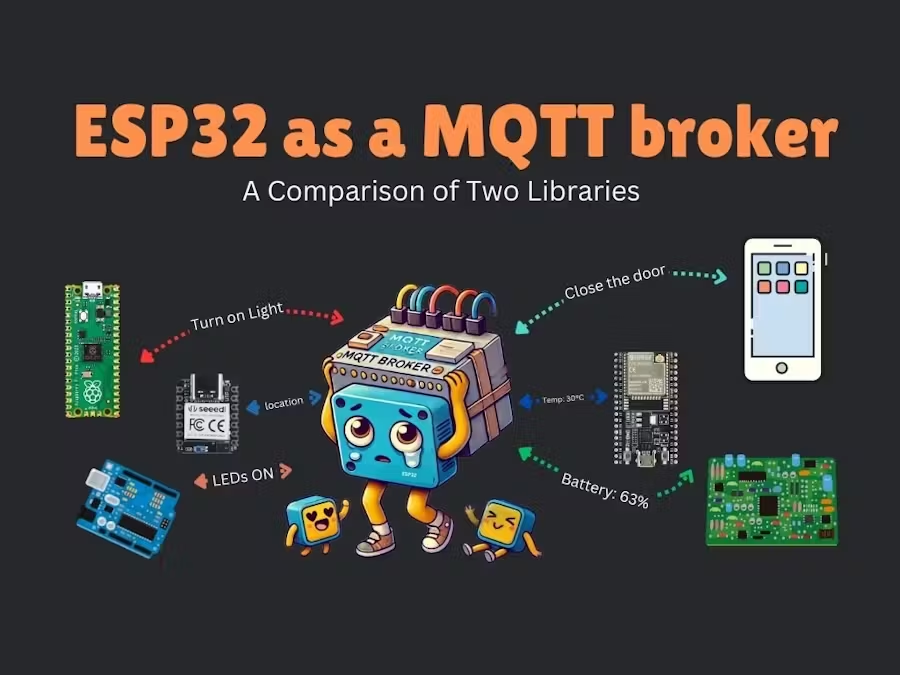
MQTT broker ESP32: A Comparison of Two Libraries
In the realm of small-scale IoT projects, the ESP32 shines as a cost-effective and capable microcontroller. Pairing it with an MQTT broker offers a streamlined solution for device communication in resource-constrained environments. In this blog, we’ll compare two libraries that enable the ESP32 to function as an MQTT broker: PicoMQTT and SMQTT Broker. Both libraries cater to lightweight setups but differ in their feature sets and performance.
This blog is sponsored by NextPCB, a reliable manufacturer of multilayer PCBs. Make sure to check their website and offers.

PicoMQTT: A Versatile Library with QoS Limitations
PicoMQTT is a powerful library that supports both client and broker modes, making it a flexible option for ESP32 projects. Built for high performance, it adheres to the MQTT 3.1.1 protocol and is particularly efficient in managing limited resources.
Key Features
- WebSocket support: Enables communication over HTTP for better integration with web-based systems.
- ArduinoJson integration: Simplifies the handling of structured data.
- Memory efficiency: Designed with resource-constrained devices like the ESP32 in mind.
Limitations
Despite its versatility, PicoMQTT comes with certain trade-offs:
- QoS Level 0 only: Messages are delivered on a “best-effort” basis, with no guarantees of delivery.
- Limited board support: Compatible only with ESP32 and ESP8266 devices.
The library’s author acknowledges these limitations, emphasizing its suitability for small projects with a handful of devices and infrequent data transmissions.
SMQTT Broker: A Secure and Lightweight Option with QoS 1 Support
SMQTT Broker is designed specifically for broker mode on the ESP32, focusing on lightweight operations and enhanced reliability. Unlike PicoMQTT, it brings security and improved message delivery into the equation.
Key Features
- Secure communication: Built-in support for username and password authentication ensures only authorized devices can connect.
- QoS Level 1: Guarantees that messages are delivered at least once, improving reliability for critical applications.
Limitations
- Protocol version: Like PicoMQTT, it only supports MQTT 3.1.1.
For projects that prioritize security and message reliability, SMQTT Broker’s features provide a compelling advantage.
Setting Up an MQTT broker ESP32
Both PicoMQTT and SMQTT Broker offer straightforward examples for setting up an MQTT broker on an ESP32. Here’s a high-level overview of the process:
Code for PicoMQTT: https://github.com/HighVoltages/ESP32-as-MQTT-broker
Code for sMQTTbroker: https://github.com/HighVoltages/ESP32-MQTT-broker
Authentication and Security
PicoMQTT
While PicoMQTT lacks built-in authentication, developers can implement custom security measures. This typically involves:
- Verifying client IDs.
- Checking provided usernames and passwords.
- Comparing credentials against a pre-defined list.
SMQTT Broker
SMQTT Broker simplifies authentication with native support for username and password validation. Credentials are defined in the code, and the library handles the authentication process automatically.
Network Connectivity: Router vs. Access Point
Both libraries enable the ESP32 to function as an MQTT broker in two network configurations:
- Connected to a home router: The ESP32 and other devices join the same Wi-Fi network, facilitating seamless communication.
- Access Point mode: The ESP32 creates its own Wi-Fi network, allowing other devices to connect directly to it.
Switching between these modes requires minor code adjustments to either join an existing Wi-Fi network or create a soft access point.
Conclusion
PicoMQTT and SMQTT Broker both offer effective solutions for transforming an ESP32 into a lightweight MQTT broker. The choice between the two depends on your project’s specific needs:
- Choose PicoMQTT if you value versatility and plan to use both client and broker modes in a project with low messaging frequency.
- Choose SMQTT Broker if security and message reliability (QoS Level 1) are top priorities.
By carefully considering your project’s requirements—such as security, resource constraints, and message delivery needs—you can select the library that best fits your IoT setup.
Whether you’re working on a hobby project or deploying a small IoT network, these libraries demonstrate the ESP32’s ability to act as a reliable and efficient MQTT broker.

